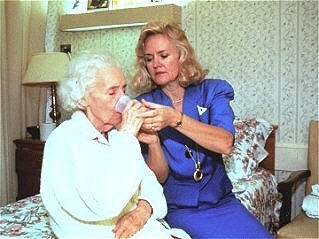Aging research (Environmental & Earth Science)
Contents
Aging research
This article, written by Tina Adler[1], appeared first in Environmental Health Perspectives—the peer-reviewed, open access journal of the National Institute of Environmental Health Sciences.
The article is a verbatim version of the original and is not available for edits or additions by Encyclopedia of Earth editors or authors. Companion articles on the same topic that are editable may exist within the Encyclopedia of Earth.
Aging Research: The Future Face of Environmental Health
With the baby boom generation quickly becoming the geriatric generation, getting old is practically trendy these days. In 1900, the over-65 age bracket accounted for only 4.1% of the population, according to the nonprofit Population Research Center. That figure doubled by 1950, hit 13% in 1997, and is expected to reach 20% by 2030. Despite their expanding numbers, older persons have failed to catch the attention of many environmental health scientists, who often tuck seniors under the broad category of "susceptible populations." Meanwhile, the environmental health of children has taken center stage.
But that's changing. The focus on children has, in some cases, spurred an interest in their grandparents. It was after being briefed on children's health projects that former U.S. Environmental Protection Agency (EPA) administrator Christie Whitman asked her staff what the agency was doing for seniors. The response was a number of unconnected studies that only indirectly related to seniors. It led to the launching in October 2002 of the EPA Aging Initiative, an effort to examine, among other topics, the environmental health hazards facing older persons. Researchers at universities and other federal agencies across the country also are exploring the topic, including the effects of agents such as air and water pollutants, sun exposure, and industrial chemicals on the aging process.
As part of the Aging Initiative, the EPA held six public forums across the country in April and May 2003, where participants discussed environmental issues of importance to elders. Speakers represented local and state governments, federal agencies, universities, and nongovernmental organizations. Among their many suggestions, speakers noted that scientists and regulators must avoid lumping everyone over age 65 into one category. Ninety-year-olds generally differ from 70-years-olds in their fortitude, and healthy 70-year-olds differ from their peers who suffer, for example, from diabetes or heart disease. Another challenge speakers put forth is to separate the contribution that environmental exposures make to aging from the many other factors that influence our health as we age.
At another EPA-sponsored forum, a December 2002 workshop titled Differential Susceptibility of Older Persons to Environmental Hazards, held at the National Academy of Sciences (NAS), Philip Landrigan, director of the Mount Sinai School of Medicine Center for Children's Health and the Environment, said the time is right for spotlighting elders. Scientists once restricted environmental assessments to young people, who generally have fewer illnesses than their elders and are easier to study, he said. Now, with our expanding computing power and knowledge of physiology and environmental exposures, studying different age groups is both possible and imperative.
The environment plays a complicated role in the lives and health of older persons. First, studies show that their leading causes of death--heart ailments, pulmonary diseases, and cancer--can all be exacerbated by environmental contaminants. Second, older bodies may not have the energy reserves to handle many assaults from their environment. Third, some scientists now suspect that certain pollutants could potentially accelerate aging, for example through the damaging effects of free radicals. Fourth, bodies can retain certain toxic compounds for years, so elders may be storing a high concentration of chemicals simply by having lived a long time. Finally, seniors also are likely to have been exposed to toxic chemicals that formerly were not regulated under federal environmental legislation.
According to Andrew Geller, an EPA senior staff leader for the Aging Initiative, one aspect essential to understanding the interaction of aging and the environment is that of exposure. He says it is largely unknown whether older adults receive different levels and types of exposure compared to younger adults, due for example to the unique behavior and activity patterns of older adults and the living environments in which older adults live. It is known, however, that the body's ability to absorb, distribute, metabolize, and excrete compounds changes over time. As a result, the same level of exposure may affect older and younger people very differently.
Scientists have tried in the past to call attention to the effects of the environment on elders. In 1985 the EPA and the NIEHS asked the NAS to investigate the topic and to recommend research strategies. The NAS did just that, publishing a report called Aging in Today's Environment in 1987. But its recommendations received little attention. Nevertheless, "the questions raised in the report were important questions then and still are," said Robert Wallace, a professor of epidemiology at the University of Iowa College of Public Health and cochair of the 2002 NAS conference. Wallace helped write a National Research Council report on the health and safety needs of older workers, which addresses environmental exposures. The report is due out at the end of the year.
Air Exposures
Air pollution is a health hazard for the elderly due to of its impact on lung function. But air pollution also has a heavy impact on the heart. "There are studies in literally hundreds of cities showing that day-to-day changes in particulate matter are associated with day-to-day changes in mortality, and most of those excess deaths are in fact cardiovascular deaths, not respiratory deaths," said Joel Schwartz, an associate professor of environmental epidemiology at the Harvard School of Public Health. Because elders are more likely to have heart disease, they are particularly sensitive to these pollutants.
A study of Denver's seniors revealed that hospitalizations for heart attacks, atherosclerosis, and pulmonary heart disease all increased during bad air days, wrote Petra J.M. Koken, a visiting fellow at the NIEHS Environmental Toxicology Program, and colleagues in the August 2003 EHP. "Dioxide appears to be related to increased hospital stays for cardiac dysrhythmias, and Monoxide is significantly associated with congestive heart failure hospitalization," they reported.
Particulate matter decreases heart rate, heart rate variability, oxygen saturation, and other key indicators of cardiac function, said Diane Gold, an assistant professor of environmental health at the Harvard School of Public Health, speaking at the 2002 NAS workshop. Older persons are more susceptible to the cardiovascular effects of particulate matter, largely because they are more likely to have heart disease, she said.
It's not just the sick who suffer, however. In one EPA study published in the May 2003 supplement to the European Respiratory Journal, healthy seniors who agreed to stay for two hours in a room containing a high, environmentally relevant concentration of particulates had adverse changes in their electrocardiograms.
Air pollution also increases the risk of stroke, particularly in people over 65, states a report published in the February 2002 EHP by Yun-Chul Hong of Korea's Inha University College of Medicine. Hong further found that stroke deaths increased in step with rising concentrations of particulates, [monoxide], sulfur dioxide, nitrogen dioxide, and ozone.
When air pollution skyrockets, local governments recommend that seniors, children, and other susceptible groups stay indoors. Even on normal days, older adults spend only about an hour outdoors, Geller says. Inside they may be bombarded by indoor air pollutants: radon, secondhand tobacco smoke, [monoxide], lead-laden dust, cockroach and dust mite allergens, pesticides, asbestos, toxicants brought home from work on the clothes of other family members, and chemicals from sprays, disinfectants, and building materials. These pollutants worsen the severity and frequency of asthma and chronic obstructive pulmonary disease among older persons, said Meryl H. Karol, a professor of environmental and occupational health at the University of Pittsburgh.
Although pulmonary conditions in older persons resulting from air pollution are fairly well known, the frequency of asthma in this population is just now coming to light. Asthma is more common among children but more severe in elders, said Steven P. Wallace, a professor at the University of California, Los Angeles, School of Public Health, speaking at the EPA-sponsored public forum in Los Angeles. Almost 14% of children under 18 have asthma, compared with 10% of people over 65. But seniors are much more likely to have daily or weekly symptoms and to end up in the hospital as a result of their asthma. According to the American Lung Association, the majority of the approximately 5,000 deaths per year resulting from asthma are among those aged 65 and older. And according to the American Academy of Allergy, Asthma, & Immunology, elderly asthmatics are usually former smokers or have a history of allergic disease.
Smoking and exposure to secondhand smoke present a host of health risks for all age groups, particularly seniors, and are the primary cause of emphysema and chronic bronchitis, states a June 2002 American Lung Association fact sheet. Indeed, all the major causes of death among the elderly are associated with smoking and secondhand smoke. The fact sheet further states that older smokers are 60% more likely to die from heart disease than their nonsmoking peers, for example.
Water Exposures
When water treatment systems fail or function poorly, gastrointestinal tracts suffer, particularly those of elders. Decline in immune function makes seniors more susceptible to most infections. "However, the degree of this increased sensitivity . . . is not well characterized," reported Elena N. Naumova and colleagues from the Tufts University School of Medicine in Boston in the April 2003 Emerging Infectious Diseases. Most prospective studies on enteric disease in older persons in the United States were carried out more than two decades ago, when few of today's pathogens were recognized, they wrote.
Naumova's team analyzed the impact on people over age 65 of a record-breaking 1993 outbreak of the bacterium Cryptosporidium parvum in Milwaukee, which resulted from a failure in the city's water filtration system. The daily rates of gastrointestinal illness increased by 0.44 events per 100,000 persons for every additional 10 years of age, the team reported. Compared with younger adults, older persons were at greater risk of becoming quite ill from the bacterium, of picking it up from other people instead of just from drinking the water, and developing symptoms more quickly, the team reported. Nationwide, 9% of gastrointestinal-related hospital admissions for people over age 65 are due to contaminated drinking water, Schwartz and colleagues reported in the January 2000 Journal of Epidemiology and Community Health.
One water pollutant that hits elders where they are particularly vulnerable--their arteries--is, surprisingly, arsenic. The chemical is best known for its role in tumor formation. But studies have also demonstrated a link between elevated water arsenic concentrations and atherosclerosis and vascular diseases. The link was first reported in a 1969 article on copper smelter workers exposed to arsenic, reported Petia P. Simeonova of the National Institute for Occupational Safety and Health and colleagues in an EHP-in-Press article (doi:10.1289/ehp.6332) posted 19 August 2003. Well water contaminated with arsenic is believed to contribute to atherosclerosis and the similar black-foot disease. New rodent studies have revealed the possible mechanism involved: arsenic accumulates in the cardiovascular tissue and triggers inflammation in the endothelium, the team reported.
Sun Exposures
Even without help from major diseases or environmental exposures, living creatures would age thanks to the progressive shortening during cell division of telomeres, the ends of chromosomes. However, telomere shortening can be accelerated by chemical reactions that occur in the body, such as when free radicals attack cells or glucose molecules interfere with proteins. Sunlight contributes to the natural aging process as well, by damaging DNA directly and by generating free radicals.
Chronic sun exposure aggravates aging-associated functional declines in the skin, said Barbara Gilchrest, chair of the Department of Dermatology at Boston University School of Medicine, at the 2002 NAS workshop. In particular, sunlight reduces the body's Langerhans cells, immune cells located in the epidermis. "The skin is a particularly instructive organ in which to examine effects of the environment, because there are sun-protected areas throughout life which serve as a control," she said. "It is very apparent in examining the skin of an older individual what that environmental impact has been."
To compound the problem, aging skin isn't very good at repairing the sun's damaging effects on DNA, Gilchrest said. She and her colleagues irradiated dermal fibroblasts, which are cells that form connective tissue, taken from sun-protected areas of newborns and adults. The newborns' cells were much faster than older cells at mending damaged DNA, due to the older cells' decreased levels of repair enzymes, they reported. The study appeared in May 2002 in The FASEB Journal.
Skin cancer, the well-known side effect of sun exposure and a widespread problem among elders, is "overwhelmingly attributable" to exposure to sunlight, Gilchrest said. More than 1 million new cases of skin cancer will be diagnosed in the United States this year, according to the American Academy of Dermatology, and more than 77% of skin cancer deaths are from melanoma. Because skin cancer can take decades to develop, the risk increases with age. "Men over the age of fifty account for more than half of all melanoma deaths in the United States," Gilchrest said.
Older Bodies' Burdens
Elders are often the keepers of family heirlooms, old memories, and cultural traditions. But insidious bits of history that they may retain quite unintentionally are toxic environmental chemicals. Once absorbed by the body, certain compounds stick around for the long haul. Lead, for example, stays in bones for decades--or in the case of women, at least until menopause. After menopause, bones begin to demineralize, which lets lead seep out and blood levels of the compound increase. In a recent investigation of women in Mexico City, the mean blood lead level was 1.98 micrograms per deciliter higher in postmenopausal than premenopausal women, reported Howard Hu, a professor of occupational and environmental medicine at the Harvard School of Public Health, and colleagues in the April 2003 EHP. This puts women at risk for many lead-related ills.
Studies have also shown that lead exposure may increase the risk of developing osteoporosis by "inhibiting activation of vitamin D, the uptake of dietary calcium The bones, and aspects of bone cell function," states an EPA-sponsored report, Exploration of Aging & Toxic Response Issues, released in February 2001. According to the National Osteoporosis Foundation, a nonprofit group that promotes public awareness of this disease, 55% of Americans over age 50 have low bone mass, putting them at greater risk for developing osteoporosis. The foundation also states the estimated national direct expenditure for osteoporotic and associated fractures was $17 billion in 2001.
Diagnosing lead poisoning in elders can prove difficult, because the symptoms resemble what we think of as the inevitable curses of old age: poor sleep patterns, slowed reaction times, irritability, and impaired visual-motor coordination, according to the 2001 EPA report. Another hazard of lead is that it can impair kidney function, causing, among other problems, some medications to clear more slowly than normal from the body. The result is a higher concentration of drug than expected and an increased risk of side effects from the medication--a concern for elders who generally consume many more prescription drugs than younger people.
Lead, aluminum, iron, copper, organochlorine compounds, and hydrocarbons have all been implicated in the common neurodegenerative diseases seen in old age: Alzheimer disease (AD), Parkinson disease (PD), and amyotrophic lateral sclerosis. Each of these diseases features neuronal death in different parts of the brain. The losses go beyond the changes in cerebral blood flow, loss of neuronal cells, and reduced neurotransmitter function seen in normal aging, which result simply in slower learning speeds, recall, and reaction times, noted Peter Spencer, a professor of neurology at Oregon Health & Science University, at the NAS meeting.
Most cases of neurodegenerative diseases do not appear to have genetic causes, wrote David O. Carpenter and colleagues from the University at Albany, State University of New York, in a review article published in the February 2002 issue of EHP Supplements. But several different environmental agents may contribute to each disease.
Occupational exposure to lead, such as when welding, soldering, and electric-plating, increases the risk of developing amyotrophic lateral sclerosis by 5- to 8-fold, wrote Carpenter and colleagues. Another study, presented by Case Western Reserve University researchers at the 2000 annual meeting of the American Academy of Neurology, found that workers exposed to high levels of lead were more than three times as likely as other workers to develop AD. Epidemiological studies linking lead and neurodegenerative diseases are supported by cellular studies, which show that lead causes neuronal damage, wrote Carpenter and his colleagues.
AD, the bane of the very old, afflicts up to half of those in their mid-80s. The brains of AD patients have clumps of fibrous proteins called neurofibrillary tangles and amyloid plaques, which disrupt cell function. The plaques feature ß-amyloid, a small protein that produces reactive oxygen species and causes extensive oxidative damage to brain tissue. Metals may enable ß-amyloid, which starts out as a normal soluble protein, to become a fibrous mass, explained Teresa Kowalik-Jankowska, a chemistry professor at Poland's University of Wroclaw, and colleagues in the October 2002 EHP Supplements.
Although scientists generally view exposures to high concentrations of metals as the health risk, Ashley I. Bush, an associate professor of psychiatry at Massachusetts General Hospital and Harvard Medical School, is concerned about the normal levels of copper in the brain required for metabolism. As we age, the brain's capacity for regulating even that normal concentration of copper weakens, and the amount of copper in the brain increases, he says. Copper in food probably doesn't enter brain tissue, because proteins and other molecules in food prevent excessive amounts of copper from passing from the gut to the blood, he says.
But copper in solution, such as in the water, may pose a risk, Bush notes. A copper solution mixed with cholesterol appears to be a particularly unhealthful combination, reported D. Larry Sparks, a senior scientist at the Sun Health Research Institute in Sun City, Arizona, and Bernard Schreurs, an associate professor at West Virginia University in Morgantown, in an article (doi: 10.1073/pnas.1832769100) posted 14 August 2003 at the Proceedings of the National Academy of Sciences.
Earlier studies had shown that rabbits fed a cholesterol-rich diet developed plaques similar to those seen in humans with AD. Also, cholesterol-fed rabbits that drank distilled water developed fewer plaques than animals that drank tap water that was later found to contain a high concentration of copper. In Sparks and Schreurs's study, rabbits with high cholesterol drank either copper-enriched water or regular distilled water, and the latter developed fewer plaques and plaque precursors than the other rabbits did. The treated rabbits also performed poorly on a task rabbits normally do well on: learning to close their eyes at the sound of a noise that is always followed by a puff of air in their faces. Copper combined with cholesterol may prevent the brain from ridding itself of ß-amyloid, the authors wrote.
PD is the second most common neurodegenerative disease, following AD. According to the American Parkinson Disease Association, a research and patient education group, PD affects more than 1.5 million people in the United States, most of whom are over 60, although the disease is appearing more frequently in younger adults. People with PD lose dopamine-producing brain cells, which are critical to normal motor function and, to a lesser extent, cognition. Despite the frequency of the disease and decades of intense research, the etiology of PD and the mechanism underlying the selective neuronal loss remain unknown, wrote Bin Liu, then a neuropharmacologist at the NIEHS, and colleagues in the June 2003 issue of EHP.
Polychlorinated biphenyls and pesticides including dieldrin and lindane are suspected of contributing to PD. Both are elevated in the brains of some PD sufferers. Exposure to the pesticide paraquat increases the risk of PD more than threefold, Carpenter's group wrote. In animal studies, exposure to pesticides caused dopamine depletion and parkinsonian behavioral changes. PD may represent the final outcome of an interaction among a vulnerable dopaminergic system, a genetic predisposition, and an exposure to environmental toxicants that cause inflammation in the brain, Liu and colleagues wrote.
Like lead, methylmercury is perhaps more commonly known as a threat to children's health, but can come back to haunt people in their golden years. It appears to impair blood pressure regulation and heart rate variability and to increase the risk of developing heart disease, according to Toxicological Effects of Methylmercury, a 2000 report by the National Research Council. "Some research demonstrated adverse cardiovascular effects at or below [methylmercury] exposure levels associated with neurodevelopmental effects," the report stated.
Minding Our Elders
As part of its mission to understand the role of environmental factors in human health and disease, the NIEHS supports research on how a variety of environmental agents impact elders. "This is an area that we have been interested in for some time," said NIEHS deputy director Samuel Wilson at the 2002 NAS meeting. The institute has invested approximately $10 million in projects that examine the relationship between age and environmental exposures, he said. The projects have focused on neurotoxicology, neurodevelopment, respiratory disease, cancer, and other chronic diseases.
The NIEHS has made a similar investment in projects investigating diseases that cause premature aging, such as Werner syndrome. "All of these inherited diseases have allowed us to understand pathways . . . that must function properly in order to prevent premature aging," Wilson said. In addition, in 2002, the NIEHS began a five-year, $20 million initiative to identify environmental exposures that may increase the risk of developing PD. The initiative will also support research on preventing and treating the disease.
The National Institute on Aging runs the Baltimore Longitudinal Study of Aging. Begun in 1958, this study is the longest-running scientific study of human aging in the United States. However, it is just now planning its first in-depth study of the effects of environmental health hazards on elders and aging, said study director Luigi Ferrucci.
Ferrucci described environmental health science as "very important--it's the future of research in human health." The work involved, however, "is very sophisticated and expensive." His team will measure trace elements of lead, aluminum, and polychlorinated aromatic hydrocarbons in the urine and blood of 1,200 adult participants, and will monitor how the levels change over time.
As part of its Aging Initiative, the EPA, with help from the NIEHS and the National Institute on Aging, is preparing the National Agenda for the Environment and Aging, due out next year. The agenda is expected to call for research and education on elders' increased susceptibility and vulnerability to pollution. "We need a better idea about how the body changes, how its capacity changes, and what the elderly are exposed to," said Harold Zenick, associate director for health at the EPA National Health and Environmental Effects Research Laboratory in Research Triangle Park, North Carolina. Because older adults spend so much time indoors, said Geller, one path for reducing potential risk to the older population is to disseminate information on how to avoid known hazards in the indoor environment through health providers, peer volunteers, and other stakeholders in the aging community.
In addition to research and educational outreach efforts in public health, the EPA will, through its initiative, investigate unique ways in which elders impact the environment. One example is the effect of large amounts of medications entering the waste stream resulting from the high degree of multiple pharmaceutical use in the aging adult population. The agency will also encourage older Americans to volunteer on environmental projects in their communities. The administration is requesting $1 million for its Aging Initiative in fiscal year 2004, which would support intramural research and public education programs.
Many speakers at the EPA's public forums took the opportunity to criticize the agency for weakening air pollution regulations that are so critical to protecting the health of seniors. "Not only is the American Lung Association deeply concerned about the ravaging effects on health from air pollution, we are also dismayed by the inadequate . . . response from EPA to combat these pollutants," said Anthony DeLucia, chair of the association's national board of directors. "Instead of recognizing the requirement for dirty power plants and industrial facilities to clean up when they increase pollution, EPA is granting them a free ride on the lungs of our seniors by rolling back new source review protections in the Clean Air Act."
Darrell Smith, director of the public health team for the American Chemistry Council in Arlington, Virginia, argued that existing government regulations and risk assessments are adequate to protect older persons from environmental pollutants. "Long-standing risk assessment and standard testing approaches are designed to provide information that can conservatively protect aging individuals," said Smith. "Commonly used animal tests such as chronic toxicity and carcinogenicity studies entail exposures throughout the lifetime." The EPA should focus on education and outreach efforts, such as educating elders on safe chemical and pharmaceutical use, he said.
A search of scientific journals, historical texts, and websites on aging reveals that one aging-related topic--how to slow down the aging process--continues to receive a wealth of attention, from serious scientists to serious hucksters. While no one in the environmental health arena is promising that their research will lead to the fountain of youth, protecting people at all stages of life from environmental toxicants may at least forestall or decrease some of the diseases facing elders, thereby enabling them to make the most of their advancing years. And in turn, this research may enlighten society as to the long-term effects on the environment of human actions, possibly leading to a healthier environment for young and old alike.
Reference
Editor's Note
- ^ Tina Adler, a freelance writer and editor specializing in health and science.




